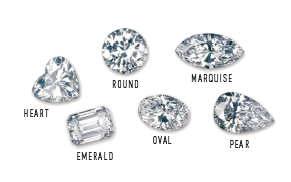A diamond’s cut and its shape are often confused, but we’re here to help! A diamond’s shape refers to its outline when viewed face up. A diamond’s cut refers to its facet arrangement.
Diamonds are renowned for their ability to transmit light and sparkle so intensely.
 The quality of cut is crucial to the diamond’s final beauty and value. Of all the 4Cs, it is the most complex and technically difficult to assess.
The quality of cut is crucial to the diamond’s final beauty and value. Of all the 4Cs, it is the most complex and technically difficult to assess.
The GIA Cut Grading System for the standard round brilliant diamond evaluates seven components. The first three, brightness, fire, and scintillation, consider the diamond’s overall face-up appearance. The remaining four, weight ratio, durability, polish, and symmetry, assess a diamond’s design and craftsmanship.
Brightness: Internal and external white light reflected from a diamond
Fire: The scattering of white light into all the colors of the rainbow
Scintillation: The sparkle a diamond produces, and the pattern of light and dark areas caused by reflections within the diamond
The design and craftsmanship of the diamond considers weight ratio (weight of the diamond relative to its diameter), the diamond’s girdle thickness (which affects its durability), the symmetry of its facet arrangement, and the quality of polish on those facets. Cut is oftentimes confused with the shape of the diamond. The most common diamond shape used in jewelry is the standard round brilliant. All other diamond shapes are known as fancy shapes. Traditional fancy shapes include marquise, pear, oval, and rectangular. Triangles and a variety of other shapes are also gaining popularity in diamond jewelry.
Cut is oftentimes confused with the shape of the diamond. The most common diamond shape used in jewelry is the standard round brilliant. All other diamond shapes are known as fancy shapes. Traditional fancy shapes include marquise, pear, oval, and rectangular. Triangles and a variety of other shapes are also gaining popularity in diamond jewelry.
Has this post helped you better understand the difference between cut and shape? Coming soon, we wrap up our comprehensive guide to the 4Cs with must-have information about carat weight.
In the meantime, take a refresher course on diamond clarity, diamond color, and the Diamond Grading Scales.
Updated: GIA report scales have been updated with the newest scales as of May 2014
Custom Field: Array